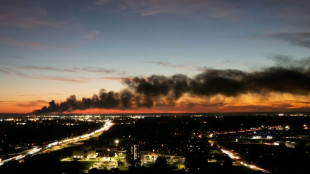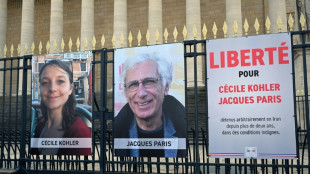
-
 On Mexico City's streets, vendors fight to make it to World Cup
On Mexico City's streets, vendors fight to make it to World Cup
-
Asian markets bounce from selloff as US jobs beat forecasts

-
 Philippine death toll tops 140 as typhoon heads towards Vietnam
Philippine death toll tops 140 as typhoon heads towards Vietnam
-
Kyrgios targets 'miracle' Australian Open return after knee improves

-
 'AI president': Trump deepfakes glorify himself, trash rivals
'AI president': Trump deepfakes glorify himself, trash rivals
-
Belgium probes drone sightings after flights halted overnight

-
 Five things to know about 'forest COP' host city Belem
Five things to know about 'forest COP' host city Belem
-
World leaders to rally climate fight ahead of Amazon summit

-
 Engine fell off US cargo plane before deadly crash: officials
Engine fell off US cargo plane before deadly crash: officials
-
Mexican leader calls for tougher sexual harassment laws after attack

-
 Meghan Markle set for big screen return: reports
Meghan Markle set for big screen return: reports
-
Japan deploys troops after wave of deadly bear attacks

-
 FIFA announce new peace prize to be awarded at World Cup draw in Washington
FIFA announce new peace prize to be awarded at World Cup draw in Washington
-
Australia's Cummins hints at return for second Ashes Test

-
 Boeing settles with one plaintiff in 737 MAX crash trial
Boeing settles with one plaintiff in 737 MAX crash trial
-
Man City win as Inter stay perfect, Barca held in Champions League

-
 French superstar DJ Snake wants new album to 'build bridges'
French superstar DJ Snake wants new album to 'build bridges'
-
Barca rescue draw at Club Brugge in six-goal thriller

-
 Foden hits top form as Man City thrash Dortmund
Foden hits top form as Man City thrash Dortmund
-
NBA officials brief Congress committee over gambling probe

-
 Inter beat Kairat Almaty to maintain Champions League perfection
Inter beat Kairat Almaty to maintain Champions League perfection
-
Newcastle sink Bilbao to extend Champions League winning run

-
 Wall Street stocks rebound after positive jobs data
Wall Street stocks rebound after positive jobs data
-
LPGA, European tour partner with Saudis for new Vegas event

-
 Eyes turn to space to feed power-hungry data centers
Eyes turn to space to feed power-hungry data centers
-
Jazz lose Kessler for season with shoulder injury

-
 League scoring leader Messi among MLS Best XI squad
League scoring leader Messi among MLS Best XI squad
-
MLS bans Suarez for Miami's winner-take-all playoff match

-
 McIlroy appreciates PGA of America apology for Ryder Cup abuse
McIlroy appreciates PGA of America apology for Ryder Cup abuse
-
Garnacho equaliser saves Chelsea in Qarabag draw

-
 Promotions lift McDonald's sales in tricky consumer market
Promotions lift McDonald's sales in tricky consumer market
-
Five things to know about New York's new mayor

-
 Anisimova beats Swiatek to reach WTA Finals last four
Anisimova beats Swiatek to reach WTA Finals last four
-
US Supreme Court appears skeptical of Trump tariff legality

-
 AC Milan post third straight annual profit on day of San Siro purchase
AC Milan post third straight annual profit on day of San Siro purchase
-
Angelina Jolie visits Ukrainian frontline city, media reports say

-
 UN says forests should form key plank of COP30
UN says forests should form key plank of COP30
-
Star designer Rousteing quits fashion group Balmain

-
 Mexico's Sheinbaum steps up cartel fight after murder of anti-narco mayor
Mexico's Sheinbaum steps up cartel fight after murder of anti-narco mayor
-
Attack on funeral in Sudan's Kordofan region kills 40: UN

-
 Key PSG trio set for spell on sidelines
Key PSG trio set for spell on sidelines
-
Democrats punch back in US elections - and see hope for 2026

-
 BMW reports rising profitability, shares jump
BMW reports rising profitability, shares jump
-
US Supreme Court debates legality of Trump's tariffs

-
 Bolivia Supreme Court orders release of jailed ex-president Jeanine Anez
Bolivia Supreme Court orders release of jailed ex-president Jeanine Anez
-
Wall Street stocks rise after positive jobs data

-
 'Hostage diplomacy': longstanding Iran tactic presenting dilemma for West
'Hostage diplomacy': longstanding Iran tactic presenting dilemma for West
-
Rybakina stays perfect at WTA Finals with win over alternate Alexandrova

-
 Le Garrec welcomes Dupont help in training for Springboks showdown
Le Garrec welcomes Dupont help in training for Springboks showdown
-
Brussels wants high-speed rail linking EU capitals by 2040


Price of victory: How Allied D-Day bombs killed French civilians
As the World War II victors celebrate the anniversary of the June 6, 1944, landings in Normandy, historians recall that 3,000 French civilians died under Allied bombs that day.
In an attempt to cut off German reinforcements rushing to the coast in response to the Allied invasion, American and British aircraft dropped bombs on main roads in several towns, including Caen, where the population believed -- in error as it turned out -- that it was safe to stay put during the raging battle on the coast.
"We saw bombs drop on Caen constantly," said Fernande Mignon, 93.
"My mother persuaded my father to let us seek shelter in the quarries," she told AFP at her home in Fleury-sur-Orne just outside Caen and close to where she grew up.
The move probably saved their lives.
Within 24 hours, 3,000 civilians had died in the firestorm unleashed by 1,500 bombers, including 700 in the town of Lisieux alone.
The number is comparable with the more than 4,600 Allied military personnel killed on D-Day, according to Commonwealth War Graves Commission figures.
Allied bombing missions reduced most town centres in lower Normandy to rubble.
After 10 weeks, the number of people who died in their homes in the area totalled 14,000.
- 'Bridgehead needed to hold' -
"If the landings were to succeed, the bridgehead needed to hold for 48 to 72 hours," said Emmanuel Thiebot, a historian and director of a memorial site dedicated to civilians in wartime.
"German reinforcements had to be slowed down for three days," he told AFP.
Main roads always ran through city centres at the time -- ring roads were to be introduced only after the war -- which put the hearts of towns and villages including Vire, Conde-sur-Noireau, Pont-L'Eveque, Flers and l'Aigle on the fire-bombing target list of the Allied command.
Residents often stepped outside their homes to watch the planes approach, assuming that they were simply flying overhead to destinations further inland, historians Francoise Passera and Jean Quellien said in a 2014 book.
But then, to the dismay of the civilians, the bomb bay doors opened over their heads and the explosives dropped.
"There was a massive tremor. We held each other, thinking that we were done for," the historians quoted a 15-year-old eyewitness as saying.
The teenage girl got away "by following mum's and dad's vague silhouettes in the blinding thick dust", she said.
People exited their homes with blood streaming down their faces.
Some were buried alive in the rubble, while others were decapitated by shell fragments.
- 'Not very efficient' -
With hindsight, the strategic wisdom of targeting city centres was actually debatable, said Thiebot.
"The tactic was not very efficient in military terms -- far from it -- because the Germans kept clear of the major roads," he said.
In fact, German reinforcements made it to the front line as early as the evening of June 6, with even more arriving the following day.
An earlier attempt by the Allies to get people to evacuate the area ahead of the assault came to little.
Pamphlets air-dropped three months before D-Day urging residents to leave "immediately" because the area "would come under attack very soon" were mostly ignored or lost in fields, unread.
Mignon ended up spending six weeks in the shelter of the quarry, sleeping on straw and living off "whatever we could find", while relentless bombing continued out in the open.
Eventually, on July 19, a Canadian arrived, telling them in Quebec-accented French that the fighting was over.
"Everybody exploded with joy," she said.
But the initial happiness quickly turned to consternation as the family discovered the destruction wrought on their neighbourhood and everything around it.
At the family home, "the windows were broken, doors were unhinged and rain was falling into the house", she recalled.
It was to take "several years" before Mignon and her family managed to get back to a "normal life", she said.
Z.AlNajjar--SF-PST



